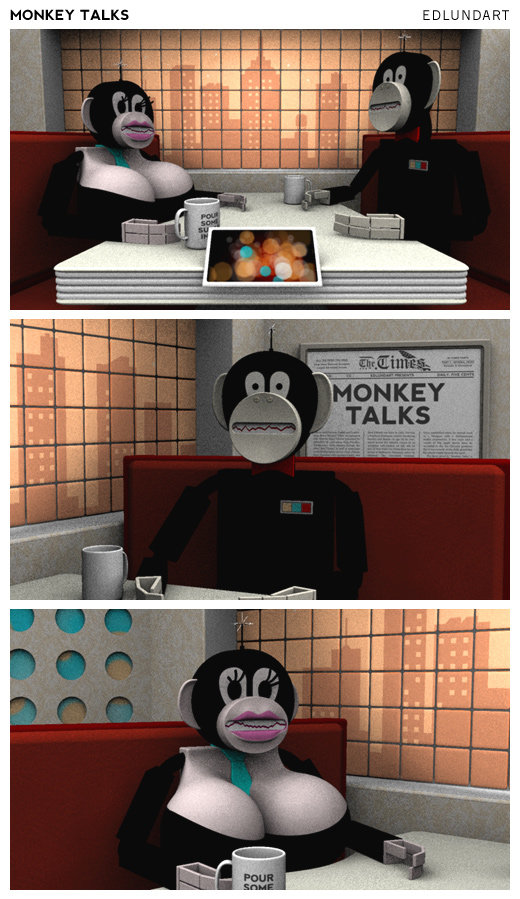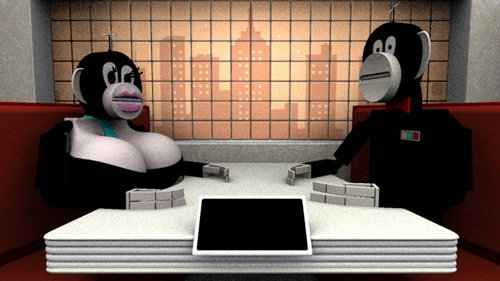-
Posts
73 -
Joined
-
Last visited
edlundart's Achievements

Apprentice (3/10)
0
Reputation
-
That was it! Awesome, thank you! I see that I even commented in the thread, yet I couldn't find this post... anyway, thanks again Rodney, and thanks again Xtas -- that tutorial is great.
-
Hello, a couple of years ago I stumbled upon a post by someone who had made a tutorial on how to switch decals using bones that he would rotate. So for example, if the bone is pointing up, a smile decal is shown, and if it's pointed down, a sad mouth decal is shown, and then you could have any number of decals inbetween at different angles of the bone. I think the bone was just placed somewhere random, it wasn't necessarily part of an object. The setup may have also included the use of expression sliders. I remember the guy who did the tutorial had an accent, possibly latin american. I thought it was very clever. I know that the always inventive johnl3d did something like this, but the tutorial I'm thinking of was a little more involved and definitely by someone else. Does this ring a bell for anyone? I thought for sure I bookmarked or downloaded it, but I can't find it anywhere. Would love to see that again, as it might be useful for a project I'm planning. Thanks.
-
Looks great, and it's really fun to see your tweaks along the way. I would just lose the drops around the fin of the one on the left. He looks more passive to me, and the drops in the air seem unrealistically suspended. I also wonder if the white horizontal lines where they're breaking the surface is too white -- it looks a bit like it was drawn on in post without accounting for the lighting in the scene. Which I guess is kind of how sprites work, although I don't really know because I've only ever used them once, in a limited way...
-

jumping on a box and jumping off again
edlundart replied to robcat2075's topic in Work In Progress / Sweatbox
Very interesting post, thanks. Your notes are instructive. -

My talk show series with monkey robots
edlundart replied to edlundart's topic in Work In Progress / Sweatbox
Hi, the 2nd episode of the show is now up: -

My talk show series with monkey robots
edlundart replied to edlundart's topic in Work In Progress / Sweatbox
Thanks for the interest and kind words so far. The show has now launched on YouTube -- . "Viewer discretion is advised," as they say on TV. Some people might find some of the content of this and future episodes offensive, as the show has a lot of sexual innuendo and some mildly politically incorrect jokes, etc. Anyway, I'm excited that it's ready and live. Read my previous posts in this thread to learn more about the way this show is produced. Thanks for your interest and support, and if you like it, please give me a 5 star rating on YouTube... I hope to post a new episode about every other week, until I have at least 12 episodes. We'll see how it all pans out -- wish me luck! -

My talk show series with monkey robots
edlundart replied to edlundart's topic in Work In Progress / Sweatbox
Paul, I see what you're saying. I dunno, that's how the grain looks I guess. I don't really mind it. bighop, this is rendered with ambient occlusion set at 12%, and with 4 passes. I have one light source brightening the back wall, but otherwise no lights in the scene. -

My talk show series with monkey robots
edlundart replied to edlundart's topic in Work In Progress / Sweatbox
No, I should have mentioned that there is no sound there yet. It's just a shot with the mouths moving. -

My talk show series with monkey robots
edlundart replied to edlundart's topic in Work In Progress / Sweatbox
Not that anyone necessarily noticed, but I promised a while back to post something about how I'm going about making my animated talk show. I think that my technical skills don't measure up to many of the great people on this forum, so if I have something to contribute, maybe it's more in the idea department. I feel like I'm making some smart choices in the production process on this thing, so maybe some of this can be useful for others. When I made "Gone," I made a series of decisions to attempt to simplify the process of making an animated film with a crew of one. I chose to make a black and white film because I figured it would save me a lot of time trying to come up with great color palettes for each scene. I used almost no textures/decals in part because I wanted to create a minimalist, geometric look, and in part because it would save time. I designed many of the shots to work without a lot of complicated motion, so that it would be easier to animate. Despite these and other time-saving measures, it still ended up taking me a year and a half to finish the film. Sure, a lot of that time was spent learning Animation Master, and even more time was spent doing everything but animating (like working a full time job, keeping a relationship alive, writing and recording songs, and working on other creative projects). But still, it was a time-consuming process. When preparing for my next project, I decided I needed to be even smarter about my time-saving measures. I wanted to get a lot of material out of not a lot of work. Ideally I wanted to come up with a way of doing an animated series without killing myself. One night I was flipping channels and came across the Tonight Show. I think Jay Leno is kind of lame, so I wasn't paying too much attention to the particulars. But the thought that came into my head was that this show was the same damn thing every night. The exact same set, the exact same camera positions, the exact same format. And it occurred to me that maybe I could make an animated talk show by making a few clips, shooting a host and a guest from various angles, and making various gestures, and then using those same shots over and over almost as clip art. So, I've been at this for a few months now, and Monkey Talks is my animated talk show series ready to debut on a YouTube near you in January 2009, or thereabouts. A lot of thinking went into making this thing plausible, so I thought I'd share some of my structural and procedural ideas. First, I decided to stick to AO renderings, because even though they take a long time to render, they save me time in setting up lights. Plus, I love the look. To save on rendering time, I went down to an occlusion sampling of 12%. Previously I had thought of that as much too low, but I have come to love the grainy look of it. To cut the rendering time even further, I decided to drop the frame rate. At first I was going to use 24 frames per second, but I did some testing and found that even 18 fps was more than acceptable. So, I'm shooting everything at 18fps. My character designs are very much a part of my time-saving thinking. I made them into robot monkeys because I love robots and monkeys, but also because I had the idea of doing robot mouths that don't really have different shapes for different vowels and consonants etc. They're just on or off. Basically, they are like spectrum analyzers on a stereo. I'm rendering every shot twice: one version where the mouths are off (ie not moving) and one where they are moving. In my video editing program, the plan is to place the talking clips on a layer above the silent clips, and simply "cut holes" in the talking clips where there is silence in my voice recordings. So, if I record a vocal take where I say "welcome to Monkey Talks," I can choose one of the shots I've rendered of the show host, and place both versions of it on my editing timeline along with the audio clip. Between the words "welcome" and "to," I cut out a couple of frames from the talking clip, revealing the silent clip underneath. The results is that the robot monkey's mouth moves when he says "welcome," stops for a fraction of a second and then starts moving again as he says "to." And on and on. test5.mov I have set up three cameras that are in set positions, and I also use a fourth "roving camera." Camera A shows the two characters in a side view. Camera B is a close-up of the host monkey Julius Larsen, while camera C is a close-up of the (permanent) guest Collette Taj. In the camera A view, one can see a little screen anchored to the edge of the table the characters sit at. I made sure that this screen is only visible from one camera, to simplify things. The idea is that I can use that screen to display anything from funny graphics, correspondent faces, or even sponsors. Basically it's a device that opens up the possibilities in the writing of the episodes. That screen could take us out of the studio and into any other world, should I want to use it for something crazy. For now, it's mostly decorative. For the first episode, I'll probably only have a couple of different shots of each character to draw from. This means the animation will be pretty stiff and repetetive. But the idea is that as time goes by, I can gradually add more and more variations, creating a deeper pool of clips to draw from. I'll eventually have a dedicated clip to use for each character doing air-quotes, or pointing in various directions, etc. The show could get more dynamically animated for each episode. This method is a more fun way for me to work, since I can get something out there sooner, and then potentially increase the quality episode by episode. I'm usually someone who sits on something until it's perfect, so switching to this mode of thinking has been rather freeing, if a bit difficult. If people find this kind of chatter to be useful, maybe I'll post some more "production thoughts" in the future. Either way -- happy holidays to you all! -

My talk show series with monkey robots
edlundart replied to edlundart's topic in Work In Progress / Sweatbox
Awesome, that seems to have been the problem! It was set to 1fps instead of 18fps (!). I just did a test render of my last frame and it matches the last frame of the original mov file, so that looks very promising. I'll have to do a full render of the whole animation to be totally sure, but I think you solved my problem. Thank you very much for your insight! -

My talk show series with monkey robots
edlundart replied to edlundart's topic in Work In Progress / Sweatbox
Hmm, I may have found a portion of the answer to my problem. I think it could be happening because the playrange settings in the timeline of my chor indicate a wider range than the range I'm actually rendering. It's set to 0-720 but I'm only rendering 0-170. When I move the playrange thing to the left on my timeline so that only frames 0-170 are highlighted and the rest is outside my rendering range, and do a test render of frame 170, I can see that it didn't help -- the mov file I'm using as a decal is still playing way too slowly. But I have a hunch that this is because AM is still "remembering" that the project file is saved with 0-720 as the playrange, and it's slowing down my mov file so that it can last across 720 frames. However, when I resave the project file with a playrange of 0-170, and then reopen the file, AM does not remember my change and still shows 0-720 highlighted! I can't get AM to remember my playrange change! The attached file shows two screenshots of the timeline playrange to help illustrate what I'm talking about. Currently my project's playrange is as shown in the top screenshot. I want to change it to the way it looks in the bottom screenshot. When I do change it to that, and save my file (project file and chor file), close and then reopen the project, for some reason it reverts back to the 0-720 playrange as shown in the top screenshot. Why? -
EDIT, JAN 22, 2009: The show has now launched! Click the link below to see it on YouTube. WARNING: The content of this and future episodes might be offensive to some viewers. The show has a lot of sexual innuendo, etc. If you like it, please help me out by giving it a 5 star rating! Thanks. ------------------------ Hi all, a couple of months after releasing my debut short film "Gone" (forum thread / ), I'm now well into my next project, the progress of which I will detail in this thread. It's a comedy talk show series featuring original robot monkey characters. The show's host is a bow-tied, somewhat snobby but snappy robot. The perpetual guest is a reluctant sex object and ardent feminist. I will post a longer description of the setup of my show later, but for now I have a question I would love some help with: Between the characters in the attached picture, you see a small black screen. I am decaling a quicktime file on that screen. It's working, except that the quicktime animation is playing too slowly. I would guesstimate that it's playing at about 1/4 the speed that the animation actually is. Why would that happen and what can I do to adjust it? To simplify matters, let's just say that the quicktime animation I'm decaling onto the little screen is 10 seconds long and features a small dot that moves from the left to the right edge. If I play this quicktime file in my quicktime player, the animation takes 10 seconds. At 0 seconds, the dot is all the way to the left, and at 10 seconds it is all the way to the right. Now, I decal this file as a .mov onto the screen in my AM chor. I render out a ten second animation from AM. The file successfully got mapped onto the little screen, and the dot is moving from left to right. BUT it's moving way too slowly, so that at 0 seconds, the dot is on the far left, but at 10 seconds, it has only moved a little bit to the right. In other words, it's really just displaying the first 25% of the quicktime animation, but stretched out over ten seconds. I am using an unusual frame rate both in my AM project and in the quicktime decal file -- it's 18fps. I'll explain later why I'm doing that, but the point is that the frame rate should be the same both in my AM project and in the .mov file I'm decaling, so I don't see how that could be causing the problem. Does anyone have any ideas? Thanks!
-
I just wanted to say that I stumbled across this thread for the first time today, and I really really REALLY appreciate the work you are doing. I don't have time to test this yet, but I'm bookmarking this thread and I have no doubt that I will find this very useful in the future. Please know that your efforts are truly appreciated. And Animus, thanks for posting that model -- it will be a quick way for me to investigate this rig further.
-
I forgot to answer Nancy earlier: The long rendering times are due to the whole film being rendered using Ambient Occlusion. It would have taken a lot less time if not for that, but I like the look... To StormedFX, I'll take that as a compliment that the film had an emotional impact! And Gerry, that's a problem I'd love to have! :-) If that happens I'll have to come up with a new production company name or just drop it altogether. It's really just for fun, after all.
-
Thanks Martin! And thanks for the great software. Gerry, I really appreciate that you took the time to share your thoughts on YouTube, and I responded there. I had to respond in two parts because there is a character limit. It was meant to be read in this order: I appreciate your comments. The "Prizeless" name is intended less as self-deprecation than a kind of jokingly bitter sentiment. I think my work is good but perhaps underappreciated because I don't do much networking or partying or schmoozing with the right people, etc. For me it's a defiant name, saying "this may not receive glitzy awards, but it's the real deal." I will likely take you up on your second point -- the "nudity" angle was a silly attempt to draw some traffic to a film that probably isn't catnip to most YouTube viewers. I'll probably change it to something less sensationalistic soon. Thanks very much for your kind words and your thoughts.












